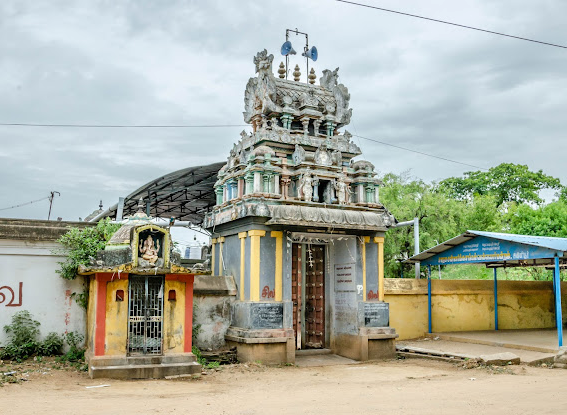During a yajna conducted by Daksha, Lord Shiva was intentionally excluded from the invitation, while others, including Agni, were invited. For attending this yajna to insult Lord Shiva, Agni faced punishment from Badrakali and Veerabadra, resulting in a curse that prevented him from attending any yajna. This curse led to failed monsoons and drought conditions. In search of relief, Agni came to this sacred place, worshipped Lord Shiva, and was ultimately freed from his curse. Consequently, the Lord is revered as Agnipureeswarar, and the sacred spring is known as Agni Theertham.
Sthala Puranam :
Dakshayani attended Daksha's yagam, but due to the insults directed at Lord Shiva by her father and the other attendees, she ultimately immolated herself in the sacrificial fire. In response to this act, Lord Shiva punished Agni for participating in the yagam, leading to a curse that prevented Agni from being involved in any rituals. This created significant issues, as no yagam can be performed without Agni, resulting in failed rains, widespread drought, and famine.
Seeking redemption, Agni came to this sacred place and worshipped Lord Shiva using the leaves of the Vanni tree. He also created a tank here, and eventually, Lord Shiva forgave him. As a result, Lord Shiva is known as Agneeswarar or Agnipureeswarar, and the place was originally called Agniyur (which later transformed into Anniyur) or Vanniyur. The name Vanniyur derives from "Vanni," which refers both to the tree whose leaves Agni used and to "fire" in Sanskrit.
Dakshayani had to be born on earth due to her attendance at Daksha's yagam. She was born as the daughter of Sage Katyayana and came to be known as Katyayani. She set her mind on marrying Lord Shiva, and the marriage was fixed and conducted at Tiruveezhimizhalai.
This temple serves as a prarthana sthalam for those suffering from blood pressure and other medical issues, as well as a Vaastu parihara sthalam. Due to its sthala puranam, it is also a place of prayer for those seeking marriage.
Notable figures who have worshipped here include Brahma, Sage Agastyar, and Sanatkumara and Sanatana.
The temple, located on the northern bank of the Arasilar River, is relatively small, with limited shrines and sub-shrines. Currently, it lacks a dhwajasthambam, suggesting it may have been larger and more prominent in earlier times. The temple dates back to the Chola period, as evidenced by the pillars in the mandapam and the detailed bas-relief images in the prakaram, depicting legends from the sthala puranam.
Administration History :
The administration of the Sri Agnipureeswarar Temple has evolved over the centuries, reflecting the changing political landscape of the region. Initially, it was likely managed by local temple authorities during the early medieval period. With the rise of the Chola dynasty, the temple came under royal patronage, leading to significant renovations and the establishment of formal management practices. Later, during the Vijayanagara and Maratha periods, the temple continued to receive support, with maintenance and extensions carried out by these rulers. In more recent times, the Nattukottai Nagarathars have played a crucial role in the temple's administration, ensuring its preservation and continued worship.
